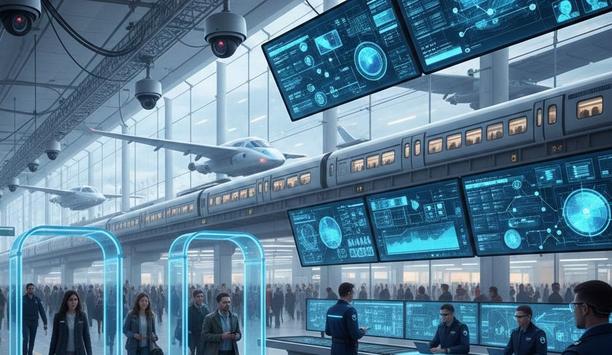Michael Byrden, Sales Director of ACT, considers the convergence of facility management. He describes how ACT, the access control manufacturer, has acquired a VMS and analytics development house in order to unify security solutions and bring customers nearer to the goal of a truly intelligent building.
Desire for open systems
Major acquisitions have been dominating the news recently and, even if this lays me open to a charge of naivety, I genuinely believe that they aren’t predatory. As more and more building disciplines are network-enabled, manufacturers are simply striving for open systems. Access control (the simple process of giving people permission to open a door) is an obvious fit with camera and video management.
The IP revolution is putting more layers of information on the same platform which means more scope for collaboration between sub-systems. Today’s BMS products are allowing bilateral exchanges of information that are correlating sets of data which would previously have gone unconnected and therefore unnoticed.
A door held ajar at a major site at the same time as an internal motion alarm occurs may be mere coincidence but as system developers, we now have the ability to flag up twin occurrences to security operators in case they indicate a break-in.
Need for ‘image-driven’ access control
Every aspect of our lives is now image-driven and it’s common for access control management systems to have pictures of the user database. At the most elementary level, it’s hardly a brainwave to have a VMS activate a PTZ camera (or begin recording at a higher resolution) when an unusual event occurs such as a user making multiple unsuccessful attempts to identify themselves to a door. An alert can appear on an operative’s screen, and the briefest visual inspection and comparison of images will establish if a bona fide employee is experiencing difficulties or an attempted intrusion is taking place.
In an extreme case such as an unexpected door activation at a plant room or server room out of hours, access control can integrate with VMS to begin high-resolution recording by every camera in the area and prompt guards to review the footage by creating a screen pop-up |
VMS and analytics for ACT
But as the result of a purchase that was part of organic growth, ACT now has VMS, video analytics and other smart functions integrated into its solution offering. There is no third party; compatibility is guaranteed, upgrades are performed concurrently across the entire range and in the rare event that systems don’t talk to each other immediately there is a single port of call for technical help. This is of course the ideal for a greenfield site but ACT continues to broaden its integration with third parties not only to give clients the choice they demand but in order to prove agile at sites where there is a need to combine with legacy equipment.
ACT’s VMS acquisition included video analytics functionality and our developers are creating a wide range of algorithms with obvious scenarios for access control usage being the definition of sterile zones and identification of loitering. Our perimeter protection work includes rail applications and we now have viable and increasingly robust behavioural alerts on would-be platform suicides. After a bad start when they were ‘oversold’ by non-technical marketers, people-counting algorithms are also increasingly practicable and the life-safety correlation between being able to open extra doors when unusually heavy footfall occurs will be obvious to anybody who so much as opens a newspaper occasionally.
Interoperability means that access control will no longer plague operators with vague alert situations that may be no more than a localised voltage problem. Convergence allows the technology to serve the user rather than operatives having to respond to imprecise alarms |
Video and access control integration
Integration of sterile zones with an access control GUI allows security officers to lock down doors and groups of doors as soon as an intrusion is suspected. First-responders can be given accurate real-time information and even allowed to view a location remotely to make decisions with optimum data. Site awareness of this kind can save lives in an ‘active shooter’ crisis at a campus environment. On the most basic level, intelligent eLock devices can now be associated with a video audit trail of door usage by activating recording when a door is opened so avoiding the need to monitor eventless footage.
Integration of VMS and access control provides multi-tiered protection for buildings against intruders who may be disaffected former employees trying to use old pin codes and cards. The user can immediately isolate a relevant video clip, analyse it and export it for evidential purposes. But equally, having been alerted to an unusual event, users of the VMS frequently realise that the alert is being caused by a legitimate member of staff who can be allowed access or given instructions from a PA system. The same ‘right to have’ and ‘right to be there’ principles of hierarchy and time zones used in access control can be used in the VMS. Thus, in an extreme case such as an unexpected door activation at a plant room or server room out of hours, access control can integrate with VMS to begin high-resolution recording by every camera in the area and prompt guards to review the footage by creating a screen pop-up. This is truly bi-directional communication.
Interoperability between VMS and analytics
I don’t need to be lectured on the Internet of Things (IoT), listen to webinars on ‘big data’ or sit through seminars at trade shows on PSIM to realise that a door controller and an IP camera, while seemingly disparate devices, are now no more than addresses on a network. And I don’t claim that it was a quantum leap to realise that my company could better serve its clients by giving them access control that provides robust visual verification through being fully integrated with VMS. I don’t like SDKs any more than my end-users do. And clients get rapid return on investment since common conventions running through the GUIs lead to reduced training costs.
Interoperability means that access control will no longer plague operators with vague alert situations that may be no more than a localised voltage problem. Convergence allows the technology to serve the user rather than operatives having to respond to imprecise alarms. Our software is analysing evidence and has the agility to discriminate between possible threats before presenting clients with real-time visibility and a call to action. Full VMS (as opposed to simple camera viewing) with analytics, PTZ and exporting of evidential clips all from a tablet used at a remote location via a native app or web browser is now becoming reality.
From facial recognition to LiDAR, explore the innovations redefining gaming surveillance


























